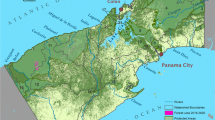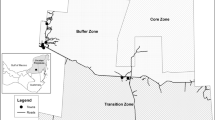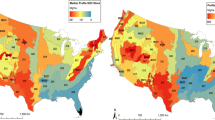Abstract
Changes in forest and agricultural land management practices have the potential to increase carbon (C) storage by terrestrial systems, thus offsetting C emissions to the atmosphere from energy production. This study assesses that potential for three terrestrial management practices within the state of Virginia, USA: afforestation of marginal agricultural lands; afforestation of riparian agricultural lands; and changing tillage practices for row crops; each was evaluated on a statewide basis and for seven regions within the state. Lands eligible for each practice were identified, and the C storage potential of each practice on those lands was estimated through a modeling procedure that utilized land-resource characteristics represented in Geographic Information System databases. Marginal agricultural lands’ afforestation was found to have the greatest potential (1.4 Tg C yr−1, on average, over the first 20 years) if applied on all eligible lands, followed by riparian afforestation (0.2 Tg C yr−1 over 20 years) and tillage conversion (0.1 Tg C yr−1 over 14 years). The regions with the largest potentials are the Ridge and Valley of western Virginia (due to extensive areas of steep, shallow soils) and in the Mid-Atlantic Coastal Plain in eastern Virginia (wet soils). Although widespread and rapid implementation of the three modeled practices could be expected to offset only about 3.4% of Virginia’s energy-related CO2 emissions over the following 20 years (equivalent to about 8.5% of a Kyoto Treaty–based target), they could contribute to achievement of C-management goals if implemented along with other mitigation measures.

Similar content being viewed by others
References
Albrecht A., S. T. Kandji. 2003. Carbon sequestration in tropical agroforestry systems. Agriculture Ecosystems Envir 99:15–27
Beck D. E., L. Della-Bianca. 1981. Yellow-poplar: characteristics and management. Agriculture handbook number 583. USDA Forest Service, Asheville, North Carolina, pp 92
Birdsey R. A. 1996. Carbon storage for major forest types and regions of the coterminous United States. In N. Sampson, D. Hair (eds), Forests and global change. Vol. 2. Forest management opportunities for mitigating carbon emissions. American Forests, Washington, D.C. pp 1–25
Brown S. L., P. E. Schroeder. 1999. Spatial patterns of aboveground production and mortality of woody biomass for eastern U.S. forest. Ecolog Applic 9:968–980
Bryce S. A., J. M. Omernik, D. P. Larsen. 1999. Ecoregions: a geographic framework to guide risk characterization and ecosystem management. Envir Pract 1:141–155
Cairns M. A., S. L. Brown, E. H. Helmer, G. A. Baumgardner. 1997. Root biomass allocation in the world’s upland forests. Oecologia 111:1–11
Cole C. V., J. Duxbury, J. Freney, O. Heinemeyer, K. Minami, A. Mosier, K. Paustian, N. Rosenberg, N. Sampson, D. Sauerbeck, Q. Zhao. 1997. Global estimates of potential mitigation of greenhouse gas emissions by agriculture. Nutrient Cycling Agroecosystems 49:221–228
Conant R. T., J. Six, K. Paustian. 2003. Land use effects on soil carbon fractions in the southeastern United States. I. Management-intensive versus extensive grazing. Biology Fertility Soils 38:386–391
Conservation Tillage Information Center (CTIC). 2000. National Crop Residue Survey. Conservation tillage data [Online]. Available by CTIC, West Lafayette, Indiana. <http://www.ctic.purdue.edu/CTIC/CRM.html> (verified 10 Feb. 2005)
Daly C., G. Taylor. 1998. Virginia average monthly or annual precipitation, 1961–90. Water and Climate Center of the Natural Resources Conservation Service. Portland, Oregon
De Roo A. P. J. 1998. Modelling runoff and sediment transport in catchments using GIS. Hydrol Proc 12:905–922
Follett R. F., J. Kimble, R. Lal. 2001. The potential of U.S. grazing lands to sequester soil carbon. Pages 401–430 In R. Follett, J. Kimble, R. Lal (eds), The potential of U.S. grazing land to sequester carbon and mitigate the greenhouse effect. Lewis Publishers, Boca Raton, Florida, 442 pp
Freibauer A., M. Rounsevell, P. Smith, J. Verhagen. 2004. Carbon sequestration in the agricultural soils of Europe. Geoderma 122:1–23
Hayden B. P., P. J. Michaels. 2001. Virginia’s climate. Virginia State Climatology Office. <http://climate.virginia.edu/description.htm>. (verified 15 april 2006)
Heath L. S., J. E. Smith. 2000. An Assessment of uncertainty in forest carbon budget projections. Envir Sci Policy 3:73–82
Huggins D. R., G. A. Buyanovsky, G. H. Wagner, J. R. Brown, R. G. Darmody, T. R. Peck, G. W. Lesoing, M. B. Vanotti, L. G. Bundy. 1998. Soil organic C in the tall-grass prairie-derived region of the corn belt: Effects of long-term crop management. Soil Tillage Res 47:219–234
Intergovernmental Panel on Climate Change (IPCC). 2000. Land use, land-use change, and forestry. Cambridge University Press, 377 pp
International Energy Agency (IEA). 2004. The prospects for CO2 capture and storage. Organization for Economic Cooperation & Development, Paris, 252 pp
IPCC. 2005. Carbon dioxide capture and storage. Cambridge University Press, 431 pp
Kerns J., M. Johnson. 1993. Conservation tillage impacts on national soil and atmospheric carbon levels. Soil Sci Soc America J 57:200–210
Kimble J. M., L. S. Heath, R. A. Birdsey, R. Lal. (eds). 2003. The potential of U.S. forest soils to sequester carbon and mitigate the greenhouse effect. CRC Press, Boca Raton, Florida
Lal R., J. Kimble, R. Follett, C. Cole. (eds). 1998. The potential of U.S. cropland to sequester carbon and mitigate the greenhouse effect. Ann Arbor Press, Chelsea, Michigan, 129 pp
McCarthy J. J., O. F. Canziani, N. A. Leary, D. J. Dokken, K. S. White. (eds). 2001. Climate change 2001: impacts, adaptation, and vulnerability. Published for the Intergovernmental Panel on Climate Change, Cambridge University Press, 967 pp + app
McClure J. P., H. A. Knight. 1984. Empirical yields of timber and forest biomass in the Southeast. Research paper SE-245. USDA Forest Service, Asheville, North Carolina, 84 pp
Moore I. D., Turner A. K., J. P. Wilson, S. K. Jenson, L. E. Band. 1993. GIS and land-surface-subsurface process modeling. Pages 213–230 In M. F. Goodchild, B. O. Parks, L. T. Steyaert (eds), Environmental modelling with GIS. Oxford University Press, New York, 488 pp
Natural Resource Conservation Service (NRCS). 1994. State Soil Geographic (STATSGO) Data Base, Data use information. Miscellaneous publication number 1492. NRCS-National Soil Survey Center, Lincoln, Nebraska, 113 pp. [Online]. Available by NRCS. <http://www.ncgc.nrcs.usda.gov/products/datasets/statsgo/index.html> (verified 10 Feb 2005)
NRCS. 2003. National handbook of conservation practices: standards 391 and 393 [Online]. Available by NRCS. <http://www.nrcs.usda.gov/technical/Standards/nhcp.html> (verified 9 Feb. 2005)
NRCS. 2004. National Food Security Act manual, fourth edition: part 511—highly erodible land determinations [Online]. Available by NRCS <http://policy.nrcs.usda.gov/scripts/lpsiis.dll/M/M_180_511.htm> (verified 11 Feb. 2005)
Odum E. P. 1969. The strategy of ecosystem development. Science 164:262–270
Omernik J. M. 1987. Ecoregions of the conterminous United States. Ann Assoc Am Geographers 77:118–125
Pacala S., R. Socolow. 2004. Stabilization wedges: solving the climate problem for the next 50 years with current technologies. Science 305:968–972
Paul K. I., P. J. Polglase, J. J Nyakuengama, P. K. Khanna. 2002. Changes in soil carbon following afforestation. Forest Ecol Manage 168:241–257
Penman J., M. Gytarsky, T. Hiraishi, T. Krug, D. Kruger, R. Pipatti, L. Buendia, K. Miwa, T. Ngara, K. Tanabe, F. Wagner. (eds). 2003. Good practice guidance for land use, land use change, and forestry. Institute for Global Environmental Strategies for the Intergovernmental Panel on Climate Change, Hayama, Kanagawa, Japan
Post W. M., K. C. Kwon. 2000. Soil carbon sequestration and land-use change: processes and potential. Global Change Biol 6:317–328
Renard K. G., G. R. Foster, G. A. Weesies, D. K. McCool, D. C. Yoder. 1997. Predicting soil erosion by water: A guide to conservation planning with the Revised Universal Soil Loss Equation (RUSLE). Agriculture handbook number 703. USDA, Washington, D.C., 384 pp
Richards K. R., C. Stokes. 2004. A review of forest carbon sequestration cost studies: a dozen years of research. Climatic Change 63:1–48
Robertson G. P., E. A. Paul, R. R. Harwood. 2000. Greenhouse gases in intensive agriculture: contributions of individual gases to the radiative forcing of the atmosphere. Science 289:1922–1925
Schimel D. S., et al. 2001. Recent patterns and mechanisms of carbon exchange by terrestrial ecosystems. Nature 414:169–172
Six J., S. M. Ogle, F. J. Bryant, R. T. Conant, A. R. Mosiers, K. Paustian. 2004. The potential to mitigate global warming with no-tillage management is only realized when practised in the long term. Global Change Biol 10:155–160
Smith J. E., L. S. Heath. 2001. Identifying influences on model uncertainty: an application using a forest carbon budget model. Envir Manage 27:253–267
U.S. Code of Federal Regulations (US CFR) (2005) Vol. 7, section 657.5. U.S. Government Printing Office, Washington, DC
U.S. Department of Agriculture, National Agricultural Statistics Service. (USDA-NASS) (2000) Published estimates of the Agricultural Statistics Database [Online]. http://www.nass.usda.gov/Quickstats/ (verified 9 Feb. 2005)
U.S. Department of Agriculture (USDA) (2004) U.S. agriculture and forestry greenhouse gas inventory: 1990–2001. Technical bulletin no. 1907. 163 pp http://www.usda.gov/oce/global_change/gg_inventory.htm (verified 10 March 2006)
U.S. Department of Energy (USDOE) (2003) Emissions of greenhouse gases in the United States 2003. Energy Information Administration. DOE/EIA-0573(2003)
USDOE. 2005. Annual energy outlook 2005: with projections to 2025. Energy Information Administration. DOE/EIA-0383(2005). Washington, D.C., 248 pp
USDOE. 2006a. Carbon sequestration regional partnerships. http://www.fe.doe.gov/programs/sequestration/partnerships/ (verified 2 February 2006)
USDOE. 2006b. Final General Guidelines. General Guidelines for the Voluntary Reporting of Greenhouse Gases (1605(b)) Program. http://www.pi.energy.gov/enhancingGHGregistry/generalguidelines.html (verified 25 April 2006)
U.S. Environmental Protection Agency (USEPA). 2003. Ecoregions of EPA Region 3: Delaware, Maryland, Pennsylvania, Virginia, and West Virginia [Online]. http://www.epa.gov/wed/pages/ecoregions/reg3_eco.htm (verified 9 May 2006)
U.S. Geological Survey (USGS) (2004) National elevation data and national land cover data. Seamless data distribution system. [Online]. Available by USGS, Eros Data Center, Sioux Falls, SD http://seamless.usgs.gov/ (verified 10 Feb. 2005)
USGS. 2005a. Multi-Resolution Land Characteristics Consortium. http://www.mrlc.gov/ (verified 10 Feb. 2005)
USGS. 2005b. National Hydrography Data Set [Online]. Available by USGS http://nhd.usgs.gov/index.html (verified 10 Feb. 2005)
West T. O., W. M. Post. 2002. Soil organic carbon sequestration rates by tillage and crop rotation: a global data analysis. Soil Sci Soc Am J 66:1930–1946
West T. O., G. Marland, A. King, W. Post, A. Jain, K. Andrasko. 2005. Carbon management response curves: estimates of temporal soil dynamics. Envir Manage 33:507–518
Winrock International. 2004. Analyzing carbon sequestration potential on agricultural lands in the pilot region. Unpublished manuscript, provided by Winrock International (Arlington, Virginia) to the authors, 18 June 2004
Wischmeier W. H., D. D. Smith. 1978. Predicting rainfall erosion losses: a guide to conservation planning. Agriculture handbook number 537. USDA, Washington, D.C., 58 pp
Acknowledgments
We thank the US Department of Energy and Southern States Energy Board for funding this research through the Southeastern Regional Carbon Sequestration Partnership (SRCSP) and Virginia Center for Coal and Energy Research; and Winrock International, a co-participant in SRCSP terrestrial sequestration studies, for collaboration. Additionally, we thank Les Fuller for technical support; Virginia Tech’s Center for Environmental Applications and Remote Sensing for use of computing facilities; and Randolph Wynne for helpful advice and suggestions.
Author information
Authors and Affiliations
Corresponding author
Rights and permissions
About this article
Cite this article
Galang, J.S., Zipper, C.E., Prisley, S.P. et al. Evaluating Terrestrial Carbon Sequestration Options for Virginia. Environmental Management 39, 139–150 (2007). https://doi.org/10.1007/s00267-005-0368-y
Received:
Accepted:
Published:
Issue Date:
DOI: https://doi.org/10.1007/s00267-005-0368-y




